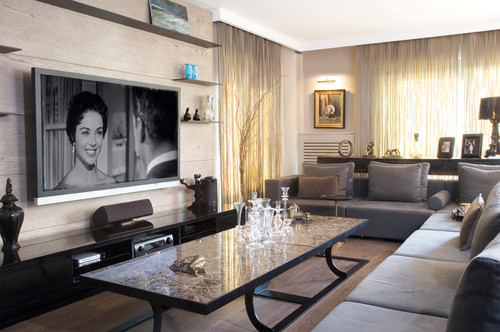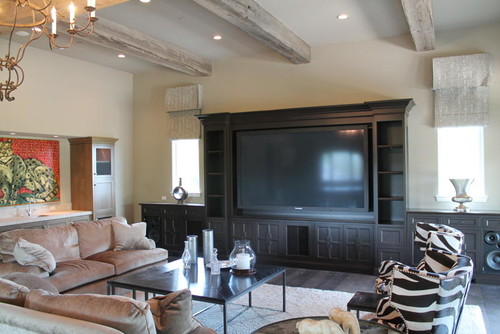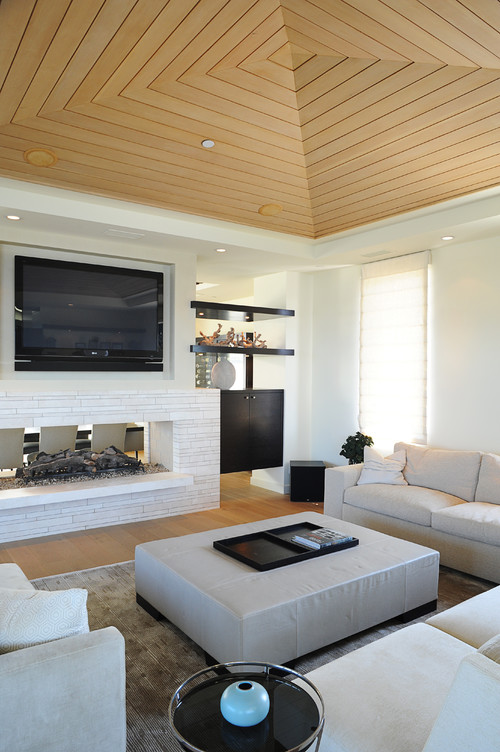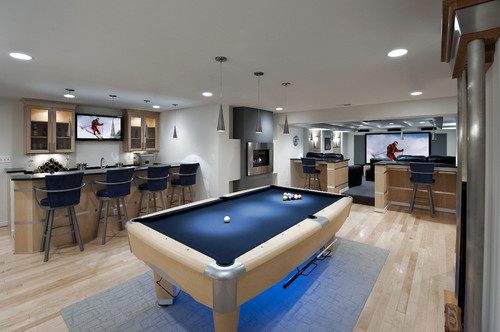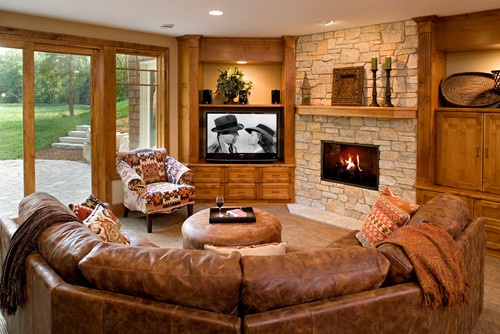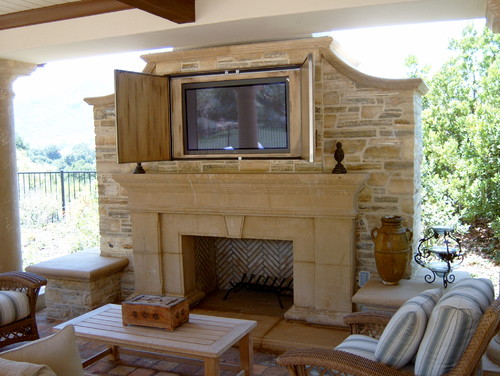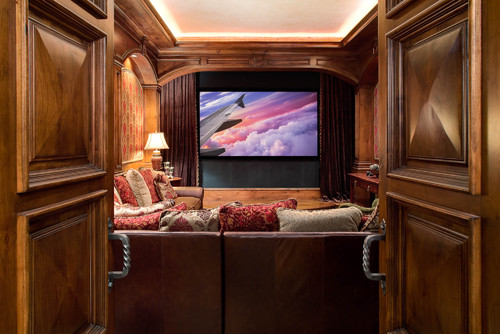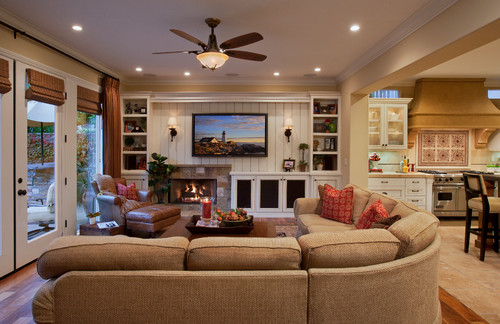How High Should Your TV Be?
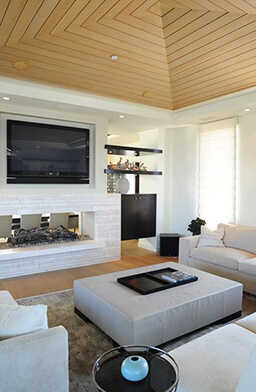
Today we look at an important question to consider when locating your television: How high should you set it?
By Matt Clawson
Houzz contributor. Home builder, project consultant, and writer. Loves sensible style.
A home without a television is like a castle in the clouds — it exists only in fairy tales. And that’s only a slight overstatement. The Nielsen Company reports that 96.7 percent of U.S. homes have television sets. In my experience, over the course of hundreds of home construction projects, I can’t recall a single instance in which one of our clients designed a home without the television’s location in mind.
This reality creates design challenges as home designers consider room orientation with the competing possible focal points of exterior views, fireplaces and televisions. Today we will look at one critical factor to consider when locating your television: height. It’s not the only thing you should think about, to be sure, but if you place your television too high in relation to its space and intended use, you might end up with regrets and, quite literally, a pain in your neck.
The General Rule
The are many issues to consider when contemplating your television viewing experience, including the size and quality of your television, and the distance from the television to the primary viewing location.
But for one characteristic, there is a simple and concrete rule: The ideal center of the screen should be at the eye level of the viewer.
So the factors that come into play when you‘re considering only the ideal height at which to place the television include the height of the typical viewer and the size of the television.
You can measure your television and do the math, but the optimum center of a television intended primarily for viewers seated on a couch is typically about 42 inches above the floor.
Historically, a general rule for optimum viewing distance from the television is 2.5 times the diagonal length of screen. Keep in mind, though, that there are different opinions on that rule, and some now recommend a TV that is larger relative to the space in a room. With newer, high-definition televisions, some recommend an optimum viewing distance of 1.5 times the diagonal television length.
For a television intended primarily for viewers seated on a sofa that is 12 feet (144 inches) away from the television, either a 55- or 60-inch television can work in the space (144 inches ÷ 2.5 = 57.6 inches), but you can certainly find examples where 65- to 70-inch televisions are used in the same circumstance.
Let’s say you select a 60-inch television. A 60-inch television is about 32 inches high, meaning the center of the screen will be at 16 inches from the bottom of the television. Most sofa seating heights are close to 18 inches above the floor, and eye level for an adult seated in a relaxed manner is about 24 inches above the seat.
That puts the optimum, center-of-television height for a typical seated viewer at 42 inches (18 inches + 24 inches). So that 60-inch television should be installed with the bottom of the screen at 26 inches above the floor.
A Television Over the Fireplace
With the parameters described above (distance = 2.5 times the diagonal length and the mid-height of the TV being at eye level of the primary viewing perspective), some media experts will tell you to never put a television over a fireplace. That is sound advice in consideration of the optimum television viewing experience from a seated viewer’s perspective. But there are also reasonable considerations that lead homeowners to decide that a TV over a fireplace is right for their circumstances.
The center of the television in the photo shown here looks to be more than 60 inches above floor level, which places the TV above optimal viewing height from the perspective of a seated viewer. But the perspective of the seated viewer is not always the No. 1 priority. Sometimes the viewing perspectives of those standing in the room are considered, while in other instances the style and feel of the space are simply the overriding factors.
A television with a screen center at 60 inches above the floor is actually close to perfect for a standing 5-foot-6 adult — not bad for sporting events when your guests are standing up and eating appetizers and talking.
If a television set over a fireplace serves as your family’s primary television, lowering the screen as much as possible can become paramount. One of the advantages of linear fireplaces that perhaps has played into their growing popularity is that the finish height can be lower than that of traditional shapes.
In the space seen here, we were able to keep the television relatively low by using a linear fireplace without a hearth or mantel. The television is not set at an ideal viewing height (the height of the center is about 5 feet), but by eschewing a hearth and mantel, we achieved a well-thought-out height that was acceptable to our client.
Different Heights for Different Circumstances
The space seen here allows for two televisions — one perfectly located for movies and daily viewing, and another located high over the bar, which is good for those standing while playing pool or casually watching the game while enjoying a drink.
In circumstances where a television is located over a bar, or in a bonus room with a pool table and other entertainment features, the ideal viewing height is less cut and dried.
All conceivable viewing perspectives need to be considered and thought through. The optimum height from the perspective of one seated at the bar might be too low for those standing around the pool table, trying to look over the heads of viewers seated at the bar. It is for this reason that you typically see televisions in commercial bars and restaurants located near the ceiling — they need to be easily viewable from many perspectives.
Trade-Offs
If there is only one television to consider, then determining the height can be a question of style over function. For some people, the television is just not that important. For others, the look of the design, and perhaps space constraints, dictate the TV location more than viewing-height parameters.
For many of us, the choice entails trade-offs. We need to consider how to orient our rooms in relation to the primary purpose of the space, considering factors such as style, comfort and traffic circulation.
A Happy Medium
Sometimes a nice balance is struck. In the space here, the television is set very close to the ideal viewing height from the sofa (the center of this TV looks to be ideally set at 42 inches above the floor), and yet the room focus feels equally balanced between the outside view, the fireplace and the television.
Design Focus
In this room it is clear that the television’s optimum viewing height from the sofa was not a priority of design, though availability of the television was.
Although this television might not be perfectly situated for enjoying a movie trilogy (the height of this television’s center looks to be about 6 feet from the floor), the stunning views out the rear windows and the modern-style fireplace surround create an inviting space suitable for contemplation or entertaining conversation.
The television height shown here is ideal for a party when many are standing around conversing as they casually watch the big game, but if anyone plans to enjoy the television primarily for extended lengths of time from a chair or couch, it may prove uncomfortable.
Determine the Use
It’s important to discuss these issues with your design and construction teams to make sure you’re prioritizing function over design, or vice versa.
Clearly a kitchen television, or one in a master bathroom, has different requirements than a main family television set up for long viewing periods. We have constructed homes with as many as 20 televisions, and they did not all need to be set at optimum viewing height.
For televisions that are not intended to be a focal point, their size and location may not be the critical factors. When a space’s primary function is not related to the TV, such as in the kitchen, the space’s primary design function should dictate the details.
But for your primary movie-watching television, the importance of height cannot be overstated. This should be considered closely along with optimum viewing distance away from the television — which, again, is 1.5 to 2.5 times the diagonal length of the screen. The center-of-television height with the eye level of seated viewers in mind, also again, is approximately 42 inches from the floor.
In the End, It’s Your Home
The optimum television viewing height does not need to be the overriding factor as you design your primary viewing area, but you absolutely should understand what the optimum viewing height is: the viewer’s eyes to the dead center of the television.
With that understanding, you can weigh the importance of a good television viewing height with other factors, such as the design style of your space.
It’s a choice you will have to make, unless you happen to be one of the rare few living without a television in that castle in a cloud.
Original Source: Houzz
Read original article here
Original article: The Province
Read original aricle here.

